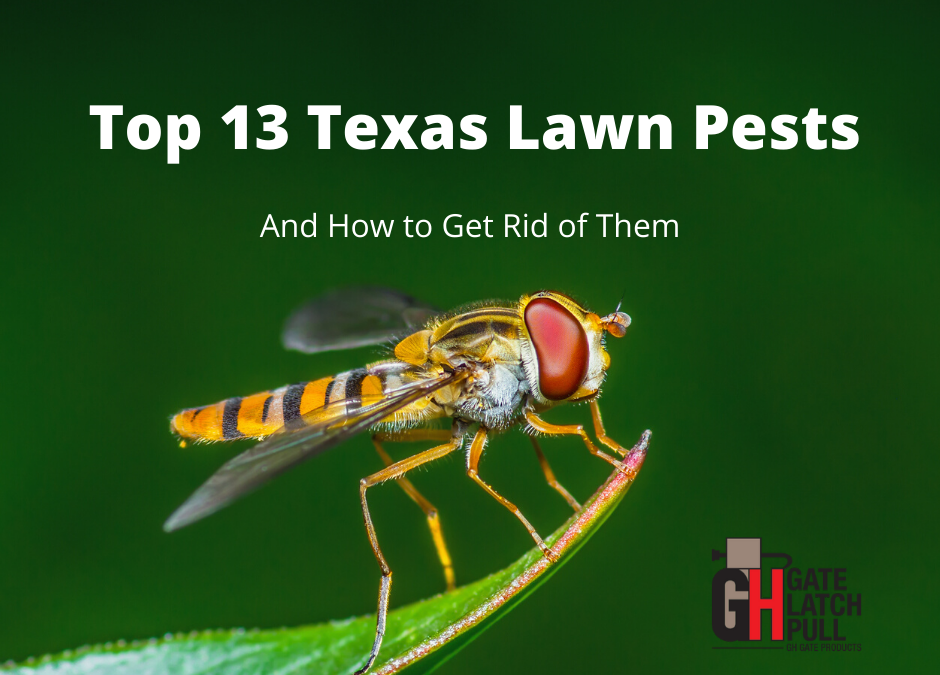Lawn Pests Common to Texas
Texas offers a warm, sunny climate that people enjoy; however, bugs and critters like it too. These pests relish in their desired climate, whether that may be warm or cooler months, and with that, they invade your lawn, gardens and even you and your home.
The list below includes common Texan lawn and garden pests, what time of year you will have problems with them, and how to prevent or control them.
1-APHIDS:
WHAT: These little pear-shaped sap sucking insects are very good at seeking out and dining on our garden plants. Most are light green or yellow, although some species come in other colors. Aphids are one of the earliest pests to appear in spring. These slow-moving insects start by feeding on the underside of leaves and quickly graduate to the tender new shoots that appear during the growing season.
WHEN: Spring
PREVENT/CONTROL: Aphids only live for about a month, but they produce extremely rapidly. When you notice them appear, grab the insecticidal soap or neem oil, spray to coat the top and underside of the plant. Repeat this daily until the Aphids are gone.
2-CABBAGE LOOPERS:
WHAT: Cabbage Loopers are light green caterpillars of the white cabbage moth family. They move by bringing their back end up to the front, forming a horseshoe-shaped loop, and then extending their front end forward. Cabbage loopers feed on members of the cole family — cabbages, broccoli, cauliflower, kale and Brussels sprouts.
WHEN: Spring
PREVENT/CONTROL: The best defense against cabbage loopers is good garden maintenance. At the end of the growing season, pull up any remains from your cole crops and compost or discard them. This helps prevent immature cabbage loopers from overwintering in your garden and re-emerging come spring. To further prevent infestation, spread floating row covers — lightweight garden fabric — over your young plants during the growing season. This keeps the adult cabbage moth from landing and laying eggs.
3-LEAFHOPPERS:
WHAT: Leafhoppers are agile, light green sucking insects that create clusters of small white spots on leaves. If left untreated, leafhoppers can cause leaves to curl or become stunted.
WHEN: Spring
PREVENT/CONTROL: Their agility makes it difficult to kill them with pesticides; Fortunately, leafhoppers have many natural enemies, such as lady beetles, lacewings and spiders.
4-SPIDER MITES:
WHAT: The most common of these pests is the two-spotted spider mite with a yellow body, and a black spot on either side of the chest. Spider mites can be identified by small amounts of webbing along the stem or tiny white speckling along the veins of a leaf. If you flip the leaf over and, and look very closely, you will find the tiny spider mites.
WHEN: Spring
PREVENT/CONTROL: The best means of killing these pests is insecticidal soap or horticultural oil. Spray the top and bottom of the leaves. Don’t forget to hit the leaf joints where spider mites can hide.
If the infestation is small, you can also clip off and destroy the infected branches. Do not compost materials infected with spider mites. Home compost piles are rarely hot enough (over 120 degrees) to effectively kill spider mites. A too-cool compost pile can become a safe harbor through winter for this pest.
5-BAGWORMS:
WHAT: Bagworms, the immature caterpillars of the family of moths can be identified by their webbed casings. These are 2-inch long, spindle-shaped cocoons made from dead leaves hanging on branches.
WHEN: Spring
PREVENT/CONTROL: With a small infestation, pulling the casings off of the tree and destroying them can do the trick. For added protection, spray insecticide during the spring months when the worms are most active. Early detection followed by the careful use of an organic pesticide will keep them in check.
With large infestations, bagworms can be persistent and eventually engulf and kill an evergreen tree. In this case, it may be necessary to take drastic measures and removing whole sections of a tree or sacrificing a seriously infected tree to protect its neighbors. If you believe you are at this stage, consult a trained arborist for help.
6-FIRE ANTS:
WHAT: The fire ant is a very aggressive ant that will attack anyone and anything that disturbs its nest. Whenever the nest is disturbed, the ants react quickly to attack the posing threat with venomous bites. Their mounds can range from a half an inch tall to several feet if left undisturbed.
WHEN: Yearly
PREVENT/CONTROL: Carefully pour a large pot (about 3 gallons) of boiling water on each mound. This will kill a mound about 60 percent of the time, and works best after a rain.
7-FLEAS:
WHAT: Fleas are tiny insects with hind legs adapted for jumping. They leave black droppings around pet sleeping areas and jump when disturbed. These pests are often picked up in grassy areas by your pet as they come in from outside. The flea has most commonly adapted to consume the blood of your household pet and will make your pet’s fur their own personal home. WHEN: Winter
PREVENT/CONTROL: If areas of your yard are heavily infested with fleas, treat these areas using a spray of beneficial nematodes. If you or your pet has been infected by fleas, first comb out the fleas, then use soapy water to kill and wash them away.
8-SPIDERS
:
WHAT: Everyone knows a spider when they see one; these 8-legged pests follow their food sources that make their way into your home during the colder months.
WHEN: Winter
PREVENT/CONTROL: Spiders can be removed with a can of spray and the destruction of any webs that have been made in your home. With more serious infestations, one should contact a pest control service.
9-CRITTERS: MICE,RATS, POSSUMS, RACOONS:
WHAT: These fury, and arguably cute critters will make their way into and under your home, seeking warmth and food. You’re likely to attract these pests if you have any cracks in the foundation in your home, or unsealed doors and windows. Signs of infestation include visible droppings and urine, gnaw marks near entry points and in your food supplies, and smudged surfaces along your walls and baseboards.
WHEN: Winter
PREVENT/CONTROL: Your best bet to prevent these unwanted guests is to first and foremost, get your foundation checked. Affirm that everything is sealed, even the smallest of openings; these critters don’t need much space to get in. This also includes securing your food and garbage receptacles. Specific pest traps are also a great option; however, if the infestation is severe, call a professional.
10-CHINCH BUGS:
WHAT: Chinch bugs are thin and less than 1/4 inch long with black bodies and white wings. If you see pinkish-red nymphs, those are probably chinch bugs. These pests feed mainly on Zoysia, Bermuda or St. Augustine grass.
WHEN: Yearly
PREVENT/CONTROL: The best way to prevent chinch bugs is to encourage the presence of birds and predator bugs in your yard by avoiding the use of lawn chemicals.
11-GRUBS:
WHAT: Grubs are 1/2 to an inch long and are white or beige, shaped like a C and have six legs. These pests are another invader of zoysia, Bermuda and St. Augustine grass, as well as buffalo grass, is the grub. Grubs eat the roots of these grasses, mostly during the summer and fall.
WHEN: Yearly
PREVENT/CONTROL: Treat for grubs from mid-June to the end of July by putting down bacillus popilliae spore, also called milky spore, which comes in a powder. This will kill the grubs. You can also release nematodes that eat grubs. It’s best to treat when there are more than five to 10 grubs per square foot.
12-CATERPILLARS:
WHAT: Caterpillars can be found any time of year, but they’re most prevalent in the spring and fall. The most common ones are the spring cankerworm, tent caterpillar, Genista caterpillar and tomato hornworm. Parasitic wasps will often take care of caterpillars for you. Prune the trees or knock the caterpillars off them with a broom, so the wasps can get at them.
WHEN: Yearly
PREVENT/CONTROL: There are some caveats about treating for caterpillars. Don’t treat trees native to Texas, like live oak, hackberry, redbud, magnolia, ash or cypress. Caterpillar appearances are natural and the trees will be fine.
13-BEETLES:
WHAT: The two most common pest beetles are the flea beetle and the cucumber beetle. The flea beetle attacks by means of their larvae feeding on the underground of roots of many vegetables; including cucumbers, tomatoes, peppers, and eggplant. These beetles create a “shotgun” pattern of feeding damage on leaves, which can simultaneously spread diseases such as potato blight and bacterial wilt.
The cucumber beetle attacks all members of the squash and cucumber family. They cause minimal feeding damage but they spread diseases, such as bacterial wilt and squash mosaic virus, that can kill plants.
WHEN: Yearly
PREVENT/CONTROL: If keeping your squash’s safe is a concern, choose disease-resistant varieties such as cougar, sunglo, and sunray. Use a plant stand to keep your plants off the ground, and mulch heavily around the plants. Always remember to remove dead plant materials and debris from your garden, and treat the soil with beneficial nematodes.


Recent Comments
Original EZGT001 Gate Latch Pull In Black
Original EZGT001 Gate Latch Pull In Black
Original EZGT001 Gate Latch Pull In Black
Original EZGT001 Gate Latch Pull In Black
Original EZGT001 Gate Latch Pull In Black